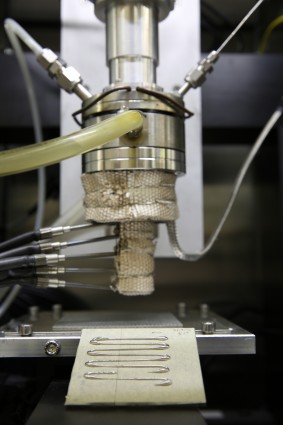Lawrence Livermore National Laboratory Tests Metal Extrusion Printing

Latest News
April 24, 2017
3D metal printing or additive manufacturing is typically accomplished using some variety of selective laser melting or sintering, which uses powdered metals to create objects or parts. Lawrence Livermore National Laboratory (LLNL) has developed a new approach to metal printing that looks a bit more like plastic printing — the new system extrudes semisolid metal through a nozzle.
 The direct metal writing process, as the lab has dubbed it, uses a metal that has been engineered to act like a solid at rest but to flow like a liquid when force is applied.
The direct metal writing process, as the lab has dubbed it, uses a metal that has been engineered to act like a solid at rest but to flow like a liquid when force is applied.
According to a press release: “Instead of starting with metal powder, the direct metal writing technique uses an ingot that is heated until it reaches a semi-solid state — solid metal particles are surrounded by a liquid metal, resulting in a paste-like behavior, then it’s forced through a nozzle.”
The lab published the results of its ongoing study in Applied Physics Letters in February.
“We’re in new territory,” said lead author Wen Chen, an LLNL materials scientist. “We’ve advanced a new metal additive manufacturing technique that people aren’t aware of yet. I think a lot of people will be interested in continuing this work and expanding it into other alloys.”
The initial tests used a bismuth-tin mixture, and the researcher said that more work would be needed before they could produce higher resolution parts using more appealing materials like aluminum or titanium. They are already working with aluminum alloys, but that will present new challenges because of the material’s higher melting point.
Once perfected, the approach could help reduce or eliminate some of the quality issues experienced with laser melting technology.
“Being able to print parts out of metal in this way is potentially important,” said staff scientist Luke Thornley, who worked on engineering the material. “So much of the work that goes into validation and analyzing for defects would be eliminated. We can use less material to make parts, meaning lighter parts, which would be big for aerospace.”
The lab previously announced new methods of printing carbon fiber and an electrophoretic deposition (EPD) process that uses light to build material in layers.
You can see the system in action in the video below.
Subscribe to our FREE magazine, FREE email newsletters or both!
Latest News
About the Author
Brian Albright is the editorial director of Digital Engineering. Contact him at [email protected].
Follow DE





